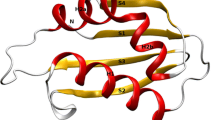Abstract
The Src homology 2 containing inositol 5-phosphatase 2 (SHIP2) catalyses the dephosphorylation of the phospholipid phosphatidylinositol 3,4,5-triphosphate (PI(3,4,5)P3) to form PI(3,4)P2. PI(3,4,5)P3 is a key lipid second messenger, which can recruit signalling proteins to the plasma membrane and subsequently initiate numerous downstream signalling pathways responsible for the regulation of a plethora of cellular events such as proliferation, growth, apoptosis and cytoskeletal rearrangements. SHIP2 has been heavily implicated with several serious diseases such as cancer and type 2 diabetes but its regulation remains poorly understood. In order to gain insight into the mechanisms of SHIP2 regulation, a fragment of human SHIP2 containing the phosphatase domain and a region proposed to resemble a C2 domain was crystallized. Currently, no structural information is available on the putative C2-related domain or its relative position with respect to the phosphatase domain. Initial crystals were polycrystalline, but were optimized to obtain diffraction data to a resolution of 2.1 Å. Diffraction data analysis revealed a P212121 space group with unit cell parameters a = 136.04 Å, b = 175.84 Å, c = 176.89 Å. The Matthews coefficient is 2.54 Å3 Da−1 corresponding to 8 molecules in the asymmetric unit with a solvent content of 51.7 %.



Similar content being viewed by others
Abbreviations
- DTT:
-
1,4-Dithiothreitol
- GST:
-
Glutathione S-transferase
- MES:
-
2-(N-Morpholino)ethanesulfonic acid
- PI(3,4,5)P3 :
-
Phospholipid phosphatidylinositol 3,4,5-triphosphate
- PI3 K:
-
Phosphoinositide 3-kinase
- PH-R:
-
Pleckstrin homology related domain
- PEG:
-
Polyethylene glycol
- Ptase:
-
Phosphatase
- PMSF:
-
Phenylmethylsulfonyl fluoride
- PTEN:
-
Phosphatase and tensin homolog
- SDS-PAGE:
-
Sodium dodecyl sulphate polyacrylamide gel electrophoresis
- SH2:
-
Src homology 2
- SHIP2:
-
SH2 containing inositol 5-phosphatase 2
- TCEP:
-
tris(2-Carboxyethyl)phosphine
References
Hamilton MJ, Ho VW, Kuroda E, Ruschmann J, Antignano F, Lam V, Krystal G (2011) Role of SHIP in cancer. Exp Hematol 39(1):2–13. doi:10.1016/j.exphem.2010.11.002
Conde C, Gloire G, Piette J (2011) Enzymatic and non-enzymatic activities of SHIP-1 in signal transduction and cancer. Biochem Pharmacol 82(10):1320–1334. doi:10.1016/j.bcp.2011.05.031
Ming-Lum A, Shojania S, So E, McCarrell E, Shaw E, Vu D, Wang I, McIntosh LP, Mui AL (2012) A pleckstrin homology-related domain in SHIP1 mediates membrane localization during Fcgamma receptor-induced phagocytosis. FASEB J 26(8):3163–3177. doi:10.1096/fj.11-201475
Ong CJ, Ming-Lum A, Nodwell M, Ghanipour A, Yang L, Williams DE, Kim J, Demirjian L, Qasimi P, Ruschmann J, Cao LP, Ma K, Chung SW, Duronio V, Andersen RJ, Krystal G, Mui AL (2007) Small-molecule agonists of SHIP1 inhibit the phosphoinositide 3-kinase pathway in hematopoietic cells. Blood 110(6):1942–1949. doi:10.1182/blood-2007-03-079699
Sasaki T, Takasuga S, Sasaki J, Kofuji S, Eguchi S, Yamazaki M, Suzuki A (2009) Mammalian phosphoinositide kinases and phosphatases. Prog Lipid Res 48(6):307–343. doi:10.1016/j.plipres.2009.06.001
Elong Edimo W, Vanderwinden JM, Erneux C (2013) SHIP2 signalling at the plasma membrane, in the nucleus and at focal contacts. Adv Biol Regul 53(1):28–37. doi:10.1016/j.jbior.2012.09.003
Suwa A, Kurama T, Shimokawa T (2010) SHIP2 and its involvement in various diseases. Expert Opin Ther Targets 14(7):727–737. doi:10.1517/14728222.2010.492780
Lee JO, Yang H, Georgescu MM, Di Cristofano A, Maehama T, Shi Y, Dixon JE, Pandolfi P, Pavletich NP (1999) Crystal structure of the PTEN tumor suppressor: implications for its phosphoinositide phosphatase activity and membrane association. Cell 99(3):323–334
Raetz CR, Guan Z, Ingram BO, Six DA, Song F, Wang X, Zhao J (2009) Discovery of new biosynthetic pathways: the lipid A story. J Lipid Res 50(Suppl):S103–S108. doi:10.1194/jlr.R800060-JLR200
Blunt MD, Ward SG (2012) Pharmacological targeting of phosphoinositide lipid kinases and phosphatases in the immune system: success, disappointment, and new opportunities. Front Immunol 3:226. doi:10.3389/fimmu.2012.00226
Berrow NS, Alderton D, Sainsbury S, Nettleship J, Assenberg R, Rahman N, Stuart DI, Owens RJ (2007) A versatile ligation-independent cloning method suitable for high-throughput expression screening applications. Nucleic Acids Res 35(6):e45. doi:10.1093/nar/gkm047
Wilkins MR, Gasteiger E, Bairoch A, Sanchez JC, Williams KL, Appel RD, Hochstrasser DF (1999) Protein identification and analysis tools in the ExPASy server. Methods Mol Biol 112:531–552
Kabsch W (2010) XDS. Acta Crystallogr D Biol Crystallogr 66(Pt 2):125–132. doi:10.1107/S0907444909047337
Evans P (2006) Scaling and assessment of data quality. Acta Crystallogr D Biol Crystallogr 62(Pt 1):72–82. doi:10.1107/S0907444905036693
Pirruccello M, De Camilli P (2012) Inositol 5-phosphatases: insights from the Lowe syndrome protein OCRL. Trends Biochem Sci 37(4):134–143. doi:10.1016/j.tibs.2012.01.002
Acknowledgments
We thank Javier Muñoz and Fernando García Martínez of the Proteomics Unit at the National Cancer Research Centre for mass spectrometry analysis. We further thank the ESRF for providing the synchrotron-radiation facilities and the staff of beamline ID29 for their assistance in the data collection. The work was supported by the Spanish Ministry of Economy and Competitiveness Grants BFU2010-15923 (to D. L.), the Comunidad Autónoma de Madrid Grant S2010/BMD-2457 (to D. L.), and by the National Cancer Research Centre. D.L. is also a recipient of awards from the Ramón y Cajal Program (RYC-2010-06948), the Volkswagen Foundation (Az: 86 416-1) and Worldwide Cancer Research (15-1177).
Author information
Authors and Affiliations
Corresponding author
Rights and permissions
About this article
Cite this article
Le Coq, J., Heredia Gallego, L. & Lietha, D. Expression, Purification, Crystallisation and X-ray Crystallographic Analysis of a Truncated Form of Human Src Homology 2 Containing Inositol 5-Phosphatase 2. Protein J 35, 225–230 (2016). https://doi.org/10.1007/s10930-016-9665-y
Published:
Issue Date:
DOI: https://doi.org/10.1007/s10930-016-9665-y




